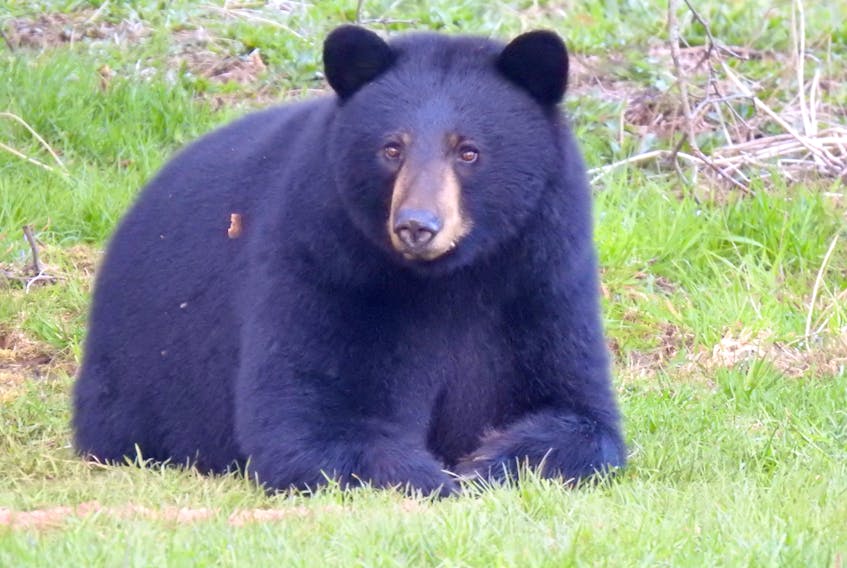WEST DALHOUSIE, N.S. — One day Sue Skipton was putting up a new mailbox at the edge of the narrow gravel road by her house. She was so focused on the job she didn’t notice the big black bear shuffling up behind her.
When she looked up it was right there. She could have reached out and touched it.
If there was ever a time to panic, that was it. But Skipton says she knew not to make any quick moves or show fear. Slowly she straightened up and calmly but firmly told the bear to go get under the apple tree. To her amazement, it lumbered away and plopped down exactly where she told it to.
It wasn’t her first brush with the big frumpy creatures that dig roots, gobble down berries by the proverbial bucket full, and love her apples and pears. Black bears eat insects and love fish too.

Skipton’s wooded property has become a Mecca for ‘ursus americanus’ and she has become the den mother to a sleuth of bears that co-exists with her many cats, her dog, and the numerous other animals that populate her 64 acres going down to Hicks Lake.
She didn’t plan it that way, but since the bears started showing up almost five years ago, she hasn’t shooed them away and they haven’t really bothered her. They co-exist. From that apple tree you can follow a well-worn bear path into the woods. There are blackberry bushes, raspberries, tall grass, wild blueberries, pears, and lots of shade. But that apple tree is the favourite spot. Back behind it are maples, ash, elm, spruce, fir, hemlock – everything you can think of.
She calls the place Serenity - Reverto ut Insontis (return to innocence). It is 64 acres of which she sold 42 acres to her sister-in-law.

PHOTOS
Skipton takes photos of her wild friends, and those digital images are making the rounds on naturalist and ecological Facebook pages. One photo shows a bear, a raccoon, and a raven almost side by side. There are photos of bears and cats seemingly unconcerned with each other. A pair of blue jays sit on the roof of Skipton’s big quonset hut. The ravens walk through the tall grass with bears scant metres away.
Skipton has had a bit of tree work done to clear fallen and damaged trees and takes some firewood off the property. It’s a mixed species forest with a lush, full canopy that is an inviting roof for all sorts of critters. She’s seen almost every kind of animal except foxes and coyotes. There’s big white roses you can smell from a mile away, and a blue muffin bush that the birds love. Her closest neighbor is two-and-a-half kilometres away towards civilization.

She’s watched the dynamic evolve every spring when the bears first come out of hibernation and become part of Skipton’s yard. Of course she’s named all the bears and watches with camera in hand. There’s Chevron, Big Momma, Lanky.
“Grumpy Bear, for instance, he’s a big old male bear that comes up, the cats will automatically go and find ground away from him,” she says. “The raccoons can be sitting with the bears. The skunks will sit with the bears. Once the cats become aware of the bears for the new year, then they’ll be out here. There’s absolutely no confrontation between any of the animals.”
DIFFERENT
“This year was different,” says Skipton. “All the cubs that are here this year are two-year-old cubs now, and they’ll go on their way this summer from their mothers. They’ve already started to break up. Because they’re two-year-olds they come back the second year, and they’re bigger – not that my cats don’t still go out and around them but my cats no longer play with them because they’re a little too big – not that they’re aggressive.”
She said when they’re new cubs, it’s a different story.

“The first year, when they first came up, the mama bears would actually set the cubs with the cats,” she says. “I could sit here and watch them. The cats and the baby bears would romp and bounce, and pounce on each other. Go rolling and come back and play again. Mama bear goes off and she forages. Does whatever she does, and when she’s ready she comes back. She gives a little click with her teeth and the baby bears just go ‘oh, mommy’s here, it’s time to go.’”
She says Hicks Lake was used by Bowater way back in the day to move logs up.
“I have a favourite rock down there that I go sit on to watch the deer jump in, bears playing in the water,” she says. “This is my world. This is where I’m most comfortable.”
Skipton was a heavy equipment operator for the military for 21 years. After that she started rescuing animals down in the Valley and she brought her rescue out to the woods with her. She has 28 spayed and neutered feral cats that live in a small sanctuary across the road from her main house.

NUISANCE
Like many residents in the area she’s heard about nuisance bears from town being brought out and set loose on what was then Bowater land.
“They’d release them there and they were sent off to make their new life,” she says.
Dropping bears off was fine as far as it went, but when the logging trucks, heavy equipment, and chainsaws started going through her property almost five years ago, things changed and the bears started moving. Skipton isn’t upset some of them have hunkered down on her land, even though it means she can’t use her land as much as she had hoped to.
“These guys need a home because the home they were dropped off in has been clear cut to the tune of 900-plus hectares,” she says, “and another 416 hectares are slated this year to be cut which they’ve already started. And since they’ve started that cut I have a further three new bears here in the yard.”
The woods past her house goes 36 kilometres south and has been a favourite spot for hunters, fishers, and people who just want to partake of the woods and nature.
“Now they’re going back there and they’re coming out and they’re just shaking their heads going ‘what are they doing?’ because it’s massive there, what they’re taking out,” she says.

FORESTRY
Skipton says she is not against forestry.
“I think that is where people get me wrong,” she says in a recent Facebook post. “I am not against good ecological, sustainable forestry which can benefit foresters, wildlife, and all that grows in a forest. What is happening is none of that and the plant life in a forest is dying, the animals are moving out, (and) the water is being destroyed by such forestry as is going on now.”
“I may be just a small heartbeat in all that is going on but even the professionals that are dealing with forest issues say the same,” she says. “The foresters can have their cake and eat it too if we make a swift move from the disasters of today and move to a better, more ecological-for-all-involved, sustainable type of forestry.”
“We’re not seeing more bears,” she says as she sits in a screened-in gazebo beside her house – just across the road from where the bears love to congregate in her small field. “We’re seeing the bears that don’t have a place to go anymore.”
Skipton isn’t alone in her theory that forestry practices are pushing wildlife out of its habitat, but Lands and Forestry Human Wildlife Conflict Biologist Mike Boudreau out of Kentville believes Skipton may have bears because they are attracted to the nearby clear-cuts, not that they are being forced out. He suspects the harvested forests provide many different food sources over the first years of regeneration.
Skipton doesn’t buy that, but at the end of the day she has bears in her yard. And she doesn’t mind.

NO HARM
She said she’s not luring the bears to her property. She admits to putting food out for the raccoons to lure them away from her cats and their sanctuary. But she even washes her tin cans and doesn’t put her garbage and recyclables out until the morning of pickup. The bears come anyway and she won’t see them picked off or sent away.
“This has become a home for them because they lost their home,” she says. “I’d rather they be here than out further in the neighbourhood and lose their life because they’re causing disturbances.”
While there are literally dozens of clear cuts in the West Dalhousie area, Skipton doesn’t touch her land any more than she has to.
“I like it the way it is,” she says.
So do the bears.
The next spring after the mailbox incident, Skipton watched as that same black bear ambled up that path out of the woods after hibernation. The first thing it did was walk over to the mailbox and sniff it from top to bottom.
“I think he wanted to see if I was still here,” she says.
(EDITOR'S NOTE: Black Bears can be dangerous and the Annapolis County Spectator does not recommend befriending them. Skipton admits to having to adapt quickly to a new lifestyle that accommodated the bears and that includes being extremely careful.)
RELATED: How to avoid problems with bears









